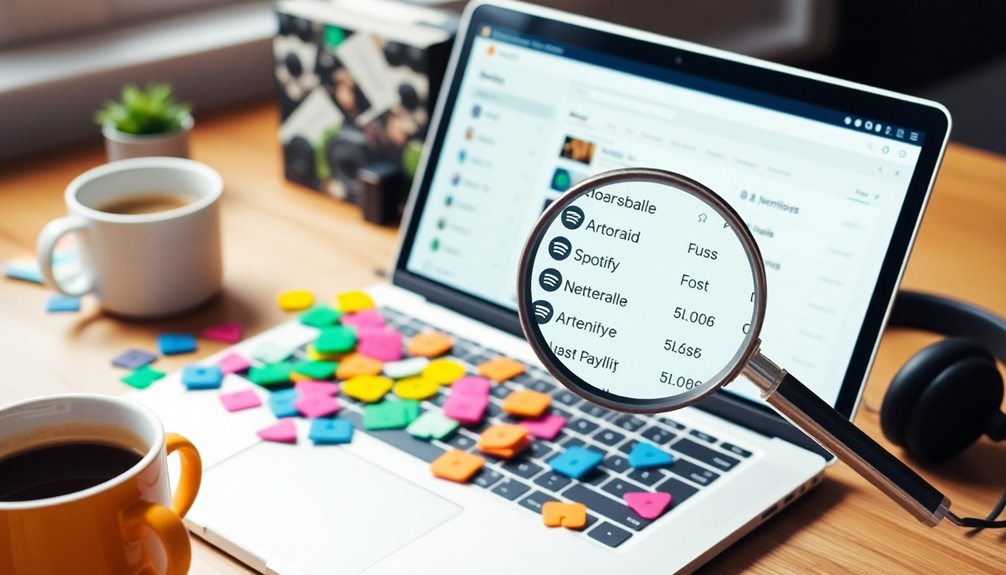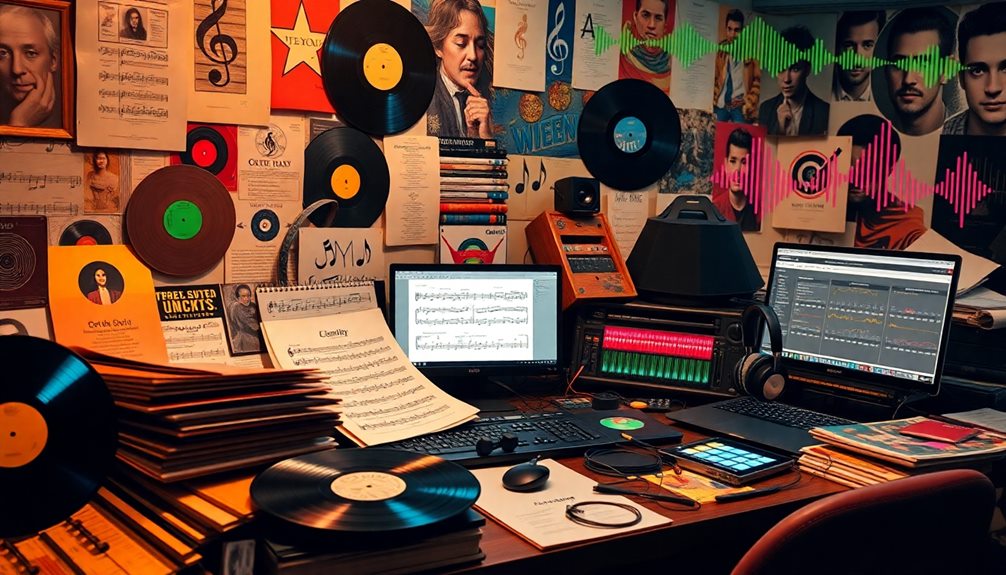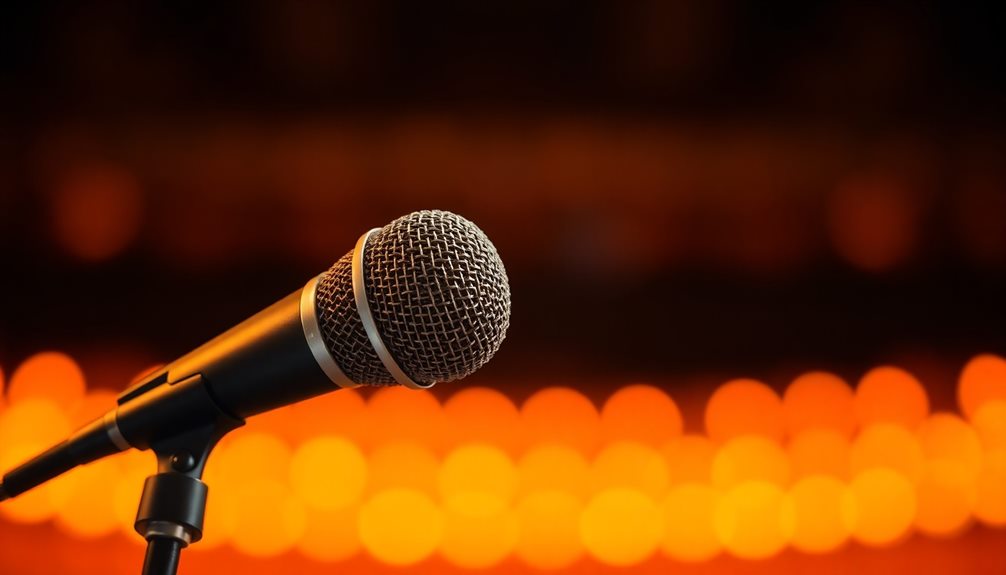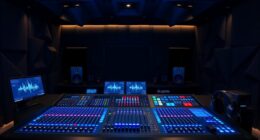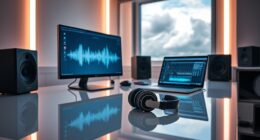When you're making music, knowing about decibels (dB) is super important! Decibels measure sound intensity, and even a small change can make a big difference in how loud something sounds. If you increase the sound by just 10 dB, it's ten times louder! To protect your ears, try to keep levels below 85 dB for long periods. For mixing, aim for about -12 to -14 dB to avoid distortion. Using decibel meters can help track levels during practice. Understanding these levels makes your performances better and safer. Keep exploring, and you'll uncover even more tips to enhance your music!
Key Takeaways
- Decibels (dB) measure sound intensity, with each 10 dB increase representing a tenfold rise in sound power.
- Sound Pressure Level (SPL) helps musicians understand safe listening levels, as 85 dB can risk hearing damage over time.
- dBu and dBV are important for understanding audio signal voltage levels, ensuring compatibility across different equipment.
- For digital audio, maintain levels around -12 dB to -14 dB FS to avoid clipping and ensure clarity in mixes.
- Using decibel meters can help musicians monitor sound levels during rehearsals, promoting optimal performance and hearing protection.
Understanding Decibels
When you plunge into the world of sound, understanding decibels (dB) is crucial. Decibels are a special way to measure sound intensity. They use a logarithmic scale, which means that a small change in dB can make a big difference in how loud something sounds.
For example, if a sound jumps from 60 dB to 70 dB, it feels much louder than going from 50 dB to 60 dB.
The starting point for measuring sound is 0 dB, which is the quietest sound a human can hear. This is called the Sound Pressure Level, or SPL. When you're a musician, knowing these details helps you create the best sound possible.
Different types of decibels exist, like dBu for voltage and dB FS for digital audio. Each one has its purpose, and understanding them guarantees your music sounds great, whether you're recording or performing.
The Logarithmic Scale
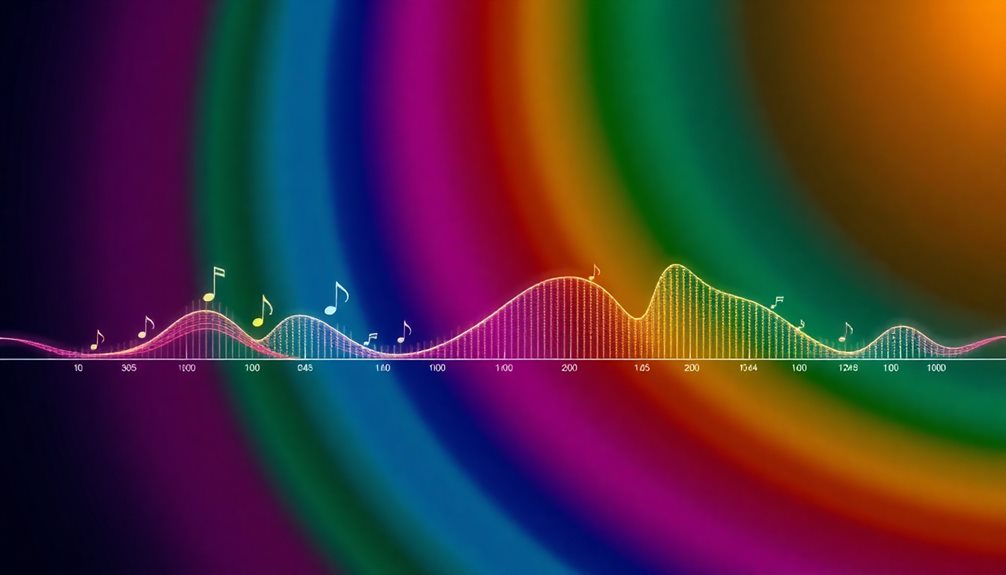
Understanding the logarithmic scale is essential for grasping how decibels function in sound measurement. The decibel scale is a fascinating way to measure sound levels. It's not just about numbers; it's about how we perceive sound. When you see an increase of 10 dB, it means the sound intensity is ten times greater! Isn't that cool?
Each increase of 3 dB actually doubles the power, which shows a non-linear relationship between sound intensity and how loud it feels. On this logarithmic scale, the difference between 1 dB and 2 dB feels the same as between 2 dB and 4 dB. This makes it easier to understand large ranges of sound levels.
For musicians, this means that when you double the voltage in your audio signal, the sound level increases by about 6 dB.
Sound Pressure Level Explained
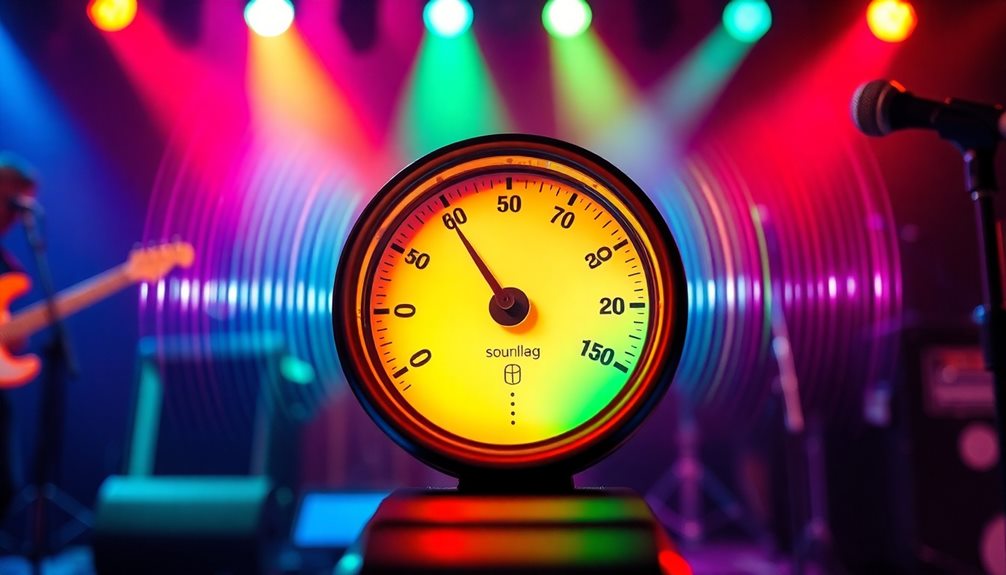
Sound Pressure Level (SPL) is a critical concept for musicians, as it quantifies the pressure of sound waves relative to a reference level. It's measured in decibels (dB SPL), where 0 dB SPL is the threshold of hearing, meaning it's the faintest sound you can detect. This level corresponds to 20 micropascals, a tiny unit of pressure.
On the other hand, the threshold of pain is around 120 dB SPL, which is incredibly loud and can damage your ears.
Every time you see an increase of 10 dB SPL, it represents a tenfold increase in sound intensity. That's why a loud rock concert can reach up to 120 dB SPL, while a normal conversation is about 60 dB SPL.
Understanding sound pressure is essential for musicians like you, not just for performance acoustics but also for protecting your hearing.
Being aware of these levels helps you enjoy music safely, ensuring that you can rock out without risking your hearing health.
Voltage Measurements in Dbu and Dbv

Voltage measurements in dBu and dBV play an essential role in the audio world, helping musicians and engineers navigate the complexities of signal levels. dBu measures signal voltage with a reference of 0.775 volts, while dBV simplifies this to 1 volt. Understanding these measurements is key for anyone working with audio.
When you're using professional audio equipment, you'll often see dBu. For example, a voltage level of +4 dBu corresponds to about 1.228 volts, which is a standard output level for many devices.
On the flip side, dBV is often used for consumer electronics. A reading of 0 dBV equals 1 volt, while -10 dBV indicates a nominal output level of 0.317 volts.
These voltage measurements are expressed in decibels, which helps you compare the strength of audio signals. The formula for calculating it's 20 • log (voltage/reference voltage).
For audio engineers, knowing dBu and dBV guarantees compatibility and maintains the integrity of audio signals across different equipment. So, whether you're setting up a stage or recording in a studio, understanding these measurements will help you achieve the best sound possible!
Digital Audio and Db FS
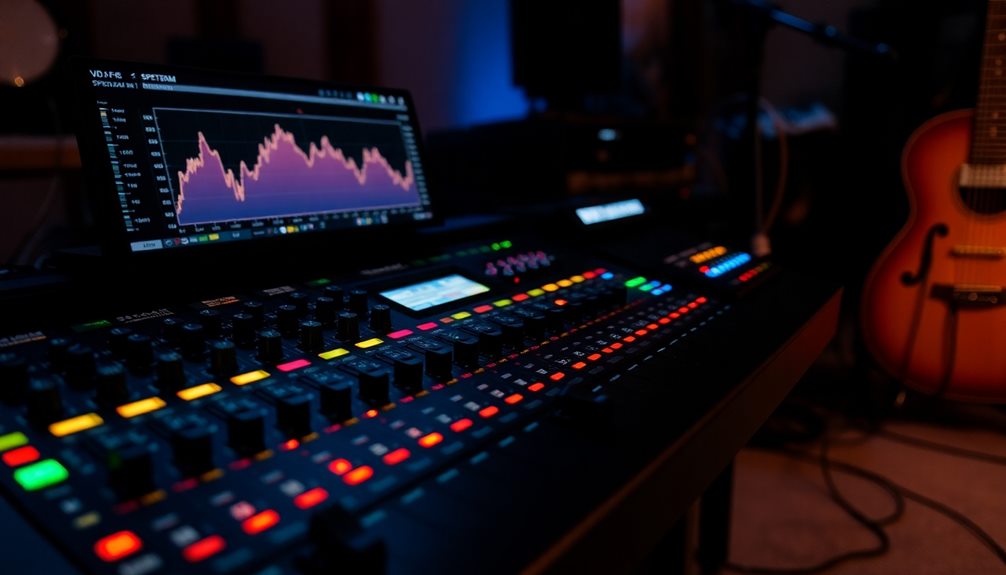
In today's digital audio landscape, you often encounter dB FS (Decibels Full Scale) as an essential measurement for managing audio levels. This scale helps you understand how your audio signals relate to the maximum level in a digital system.
When you see 0 dB FS, it represents the very top of your audio's capability. Going above this point can cause clipping and distortion, which you definitely want to avoid!
As you mix in your digital audio workstation (DAW), aim to keep your audio levels below 0 dB FS. Typically, levels around -12 dB to -14 dB RMS are great for maintaining clarity. This approach gives your mixes the headroom they need to breathe and sound their best.
Proper calibration of your gear is key, too! It guarantees that your analog and digital signals work well together, making it easier to manage those important dB FS levels.
Practical Applications for Musicians
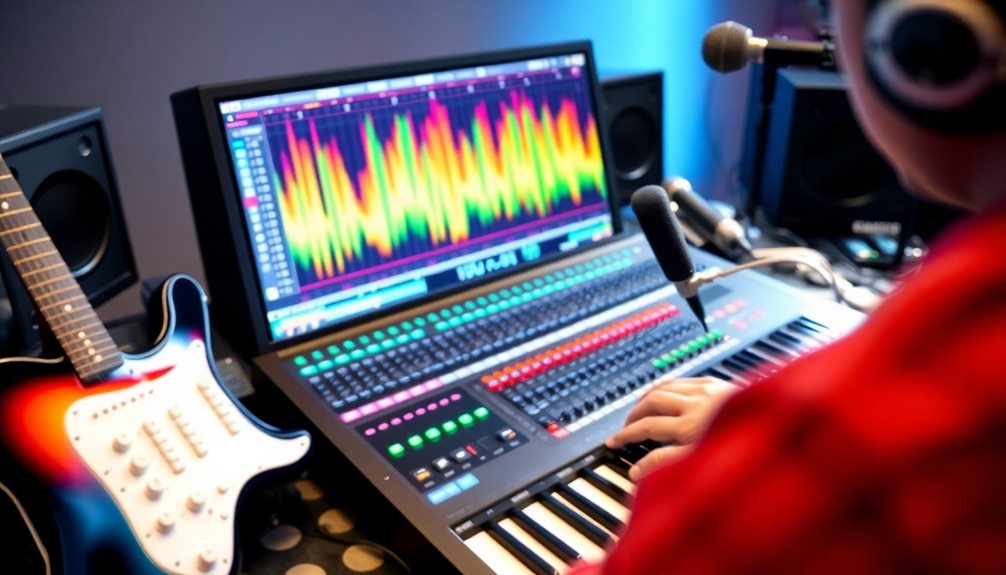
Steering through the world of audio levels can greatly enhance your performance as a musician. You need to understand something essential: sound levels are measured in decibels (dB), and knowing how to manage them can make a big difference. Aim for a mixing level between -14 dB to -12 dB RMS. This guarantees clarity and prevents distortion in your tracks.
Using decibel meters or apps is a great way to monitor levels during rehearsals and performances. Staying below 85 dB for long periods keeps your hearing safe. When you adjust your output level, remember the 3 dB rule—if you increase volume by 3 dB, you double the sound! This is super important for balancing the levels between different instruments or vocals.
Gain staging is another key concept to grasp. It helps maintain a clean signal throughout your mixing process. Familiarizing yourself with dBFS (decibels relative to full scale) in your digital audio workstation (DAW) keeps your levels below 0 dBFS, avoiding distortion.
This is your musician's guide to understanding decibels, so embrace these tools, and watch your music shine!
Frequently Asked Questions
What Db Level Should Music Be?
For music production, aim for levels between -14 dB to -12 dB RMS for clarity. During live performances, keep levels within 85 dB to 105 dB while ensuring you monitor to prevent distortion and listener fatigue.
What Do Decibels Measure in Music?
Imagine sound waves dancing through the air; decibels measure their intensity. They help you gauge volume, ensuring your music resonates beautifully without overwhelming listeners or risking damage to their precious hearing.
How to Understand Db?
To understand dB, focus on its logarithmic nature. Recognize that every 10 dB increases intensity tenfold, and be aware of different types like dBu or dBFS, essential for managing sound levels effectively.
How Many Db Is Too Loud?
Imagine a roaring lion—anything above 85 dB can harm your hearing. At 90 dB, stress kicks in; at 120 dB, pain strikes. Protect your ears, or you risk losing life's beautiful sounds forever.
Conclusion
Understanding db units can really help you as a musician! You can mix sounds better, capture your audience's attention, and create music that's just right. By knowing how decibels work, you'll feel more confident in your craft. So, whether you're recording, playing live, or just jamming with friends, remember that these sound measurements are your friends. Embrace the numbers, enjoy the music, and let your passion shine through every note! Keep rocking!


